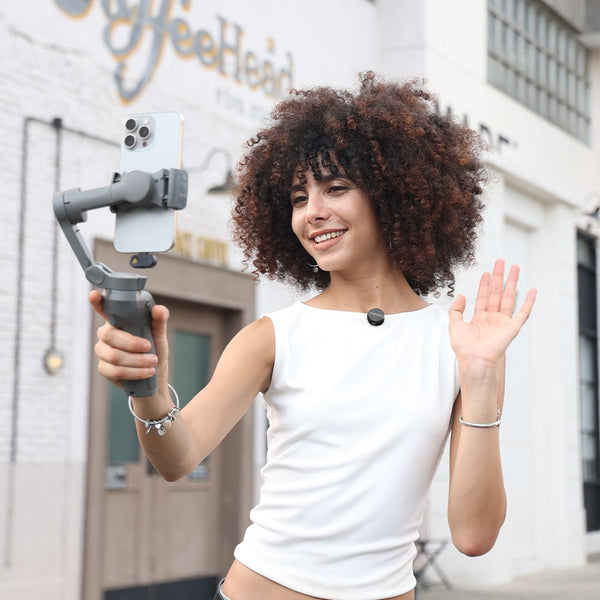Whether it's a smartphone or a tablet, the gadget you need to start your tech gadget review blog depends on your needs and budget.
The world of vlogging has exploded in recent years, and tech reviews are among the most watched and trusted content types. Whether you're unboxing the latest smartphone or testing the durability of a new tablet, how you capture and present your content matters. High-quality video is essential, but clear, crisp audio—often achieved with a wireless microphone—can make or break your review.
For beginners and seasoned reviewers alike, one common dilemma arises: Should I vlog with a smartphone or a tablet? Each has its pros and cons, and your choice can significantly affect video quality, editing workflow, and audience engagement. This guide helps you choose the best gear and setup for vlogging tech reviews using smartphones or tablets—especially when paired with the best Lavalier mics for clean, hands-free audio capture.

Smartphone & Tablet Review Setup
What’s the best smartphone camera setting for recording tech reviews?
When vlogging with a smartphone, set your camera to 4K resolution at 30fps or 60fps for crisp video quality. Use manual or "Pro" mode to adjust ISO, white balance, and focus. Lock exposure and focus to prevent the video from constantly adjusting during shooting.
Can I use a tablet to shoot high-quality gadget review videos?
Yes, tablets like the iPad Pro or Samsung Galaxy Tab S series feature excellent cameras capable of shooting in high definition. However, their size can make them harder to mount or stabilize. For tabletop demos or static recording, they work well, but smartphones are more versatile for dynamic shots.
Which apps are best for editing smartphone-based tech review footage?
Apps like LumaFusion (iOS), KineMaster (Android/iOS), Adobe Premiere Rush, and CapCut are excellent for mobile video editing. They offer advanced features like multi-track timelines, keyframe animation, chroma keying, and transitions—perfect for tech content.
How do I get professional lighting when reviewing gadgets at home?
Good lighting is crucial for showcasing product details. Use softbox lights or LED ring lights positioned at 45-degree angles to eliminate harsh shadows. For compact spaces, portable LED panels with adjustable temperature and brightness work well.
Do I need a tripod or stabilizer for vlogging with a phone?
Absolutely. A tripod ensures stable, professional-looking shots. For handheld reviews, a gimbal or stabilizer like the DJI OM series keeps your footage smooth and shake-free. Look for accessories with smartphone mounts and tilt/swivel features for flexibility.
On Video Creation and Performance
What’s the best way to showcase smartphone/tablet features in a video?
Use a combination of close-up shots and over-the-shoulder views. Highlight key features like screen responsiveness, camera quality, and multitasking in real-time use. Incorporate B-roll footage to break up the main narrative and add visual interest.
How close should I position my mic for clear vlogging audio?
For wireless microphones, place the transmitter/mic about 6–10 inches from your mouth. Lapel mics like the Maono Wave T1 Mini can be clipped discreetly onto your shirt for consistent, clear sound. Among the best iPhone lavalier mic options, this model offers excellent value for its compact form and performance. Avoid placing mics too close to prevent distortion.
How do I record voiceover audio while showing tech demos?
Use a secondary app or software to record your voiceover separately while performing your demo. Editing software allows you to sync the voiceover with the video timeline easily. Ensure you're using a clean audio source with minimal background noise, ideally using the best wireless lavalier mic for iPhone if you're working with iOS devices.
What video format and resolution are best for YouTube tech reviews?
MP4 with H.264 codec at 1080p or 4K resolution is ideal for YouTube. This format balances quality and file size, ensuring quick uploads without sacrificing visual appeal. YouTube supports multiple resolutions, but 1080p is the minimum for professional-looking reviews.
Should I film in vertical or horizontal for tech product reviews?
Horizontal (landscape) is best for YouTube and most long-form content. However, if you're targeting Instagram Reels or TikTok, shoot in vertical (portrait). For maximum content repurposing, consider filming in both formats or cropping from high-resolution footage.
Content Strategy and Engagement in Tech Review Vlogs
How long should a smartphone review video be to retain viewer attention?
Keep videos between 5-10 minutes to maintain viewer engagement. Structure content with a strong intro, product overview, feature breakdown, pros/cons, and a conclusion. Use on-screen text and chapter markers for easy navigation.
What makes a tech review more engaging for mobile viewers?
Mobile viewers prefer quick visuals, clean audio, and on-screen captions. Use punchy transitions, close-up shots, and dynamic editing to hold attention. Add value by comparing the product with its competitors or demonstrating real-world usage.
How do I build credibility as a beginner tech reviewer?
Be transparent, honest, and consistent. Share your real experience with the product and avoid overhyping. Gradually improve your production quality and engage with your audience through comments and community posts.
Can I vlog live tech reviews on platforms like Instagram or Facebook?
Yes. Both platforms allow live video, and it’s a great way to interact in real-time. Use a wireless mic like the Maono Wave T5 for better sound. It’s considered among the best Lavalier lapel microphone users looking to go live with clean audio. Prepare key talking points, monitor your comments, and test your setup before going live.
How do I add subtitles or captions to tech review videos efficiently?
Use apps like CapCut or VEED.io to auto-generate captions. YouTube also offers automatic captioning, which can be edited for accuracy. Adding captions increases accessibility and viewer retention, especially on mobile devices.
Wireless Microphones for Vlogging FAQs:
What are the best wireless microphones for tech vloggers?
The Maono Wave T5 and Maono Wave T1 Mini are top choices for wireless vlogging.
The Maono Wave T5 offers dual-channel wireless support, noise reduction, long battery life, and compatibility with phones, cameras (ideal if you're using a Lavalier mic for camera setups), and tablets.
The Maono Wave T1 Mini is compact, lightweight, and perfect for on-the-go recording with simple plug-and-play use–an excellent option from the best iPhone lavalier mic category.

How do wireless microphones connect to smartphones or tablets?
Wireless mics typically use a receiver that connects to your phone or tablet via a 3.5mm jack, USB-C, or Lightning port. Some include adapters for different devices. Always check compatibility and consider models with app control or real-time monitoring for convenience. The bBest Lavalier mics often come with universal compatibility and smart features for both iOS and Android users.
Conclusion
Whether you're a budding tech reviewer or looking to level up your content creation game, choosing the right gear is essential. Smartphones offer flexibility, great camera quality, and a wide range of accessories. Tablets, on the other hand, provide large screens for easier editing and static recording.
Pair either device with a wireless microphone like the Maono Wave T5 or T1 Mini, and you’ll ensure clear, professional audio—a must-have for holding viewers' attention. Whether you’re choosing a Lavalier mic for camera or seeking the Best wireless Lavalier mic for iPhone, investing in the right audio gear will set your tech reviews apart.
Ultimately, the best setup is the one that fits your content goals, budget, and style. Start small, focus on clarity and consistency, and grow your audience with each review you publish.
Related Article:



